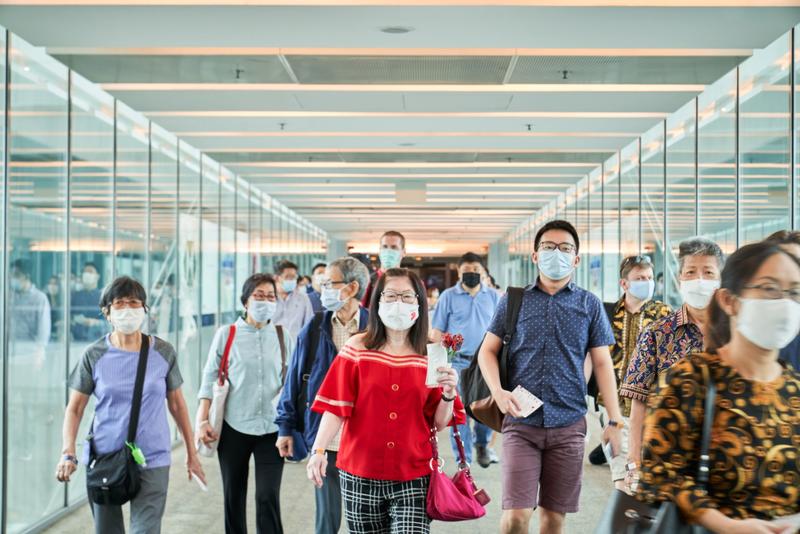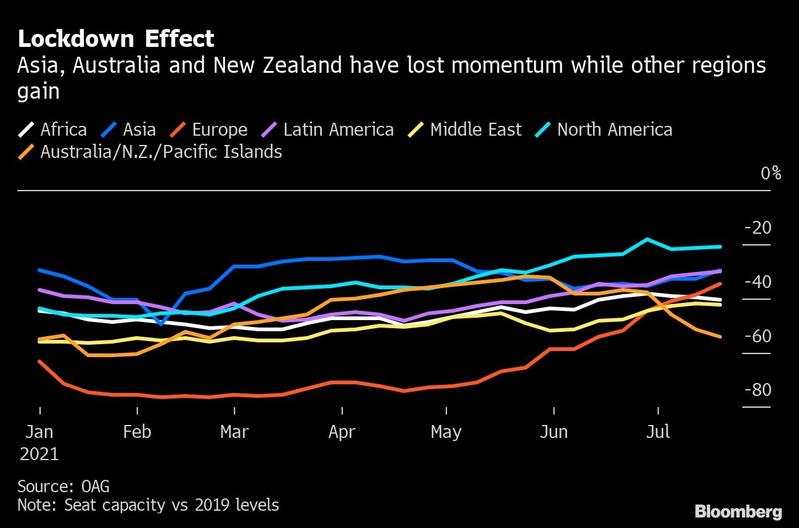 In this file photo dated Oct 24, 2020, customers wearing protective face masks walk to the aircraft to have their meal at the Restaurant A380 @Changi Experience operated by Singapore Airlines Ltd at Changi Airport, Singapore. (PHOTO / BLOOMBERG)
In this file photo dated Oct 24, 2020, customers wearing protective face masks walk to the aircraft to have their meal at the Restaurant A380 @Changi Experience operated by Singapore Airlines Ltd at Changi Airport, Singapore. (PHOTO / BLOOMBERG)
Fresh lockdowns and restrictions in Asia brought on by the faster-spreading Delta coronavirus variant are making the region’s pursuit of travel bubbles look like an increasingly fruitless endeavor.
Air-travel bubbles, corridors that allow movement between countries without the need for quarantine, have largely been a letdown as nations pull up the drawbridge again to contain outbreaks. A travel link between Singapore and the Hong Kong Special Administrative Region, first mooted last year, will be reviewed in late August. Meanwhile, talks between Australia and Singapore are still ongoing while an arrangement between Australia and New Zealand has been stop-start at best.
Globally, the picture continues to improve. With school out in Europe, the Olympics about to get underway in Japan (albeit without spectators) and Indonesia gradually recovering from its latest COVID-19 spike, aviation capacity climbed 2.3 percentage points over the past week
The patchy track record underscores how tough it will be for Asia to return to normal, with some economies clinging to a COVID-19-zero strategy, or a desire to stamp out the virus at all cost. Governments’ reliance upon strict movement controls to fight waves of infection — Melbourne last week entered its fifth lockdown while Tokyo is under a state of emergency as the Olympics dawns — is in contrast to the approach in Europe and the US, where the delta variant is spreading but where higher rates of vaccination mean travel is beginning to recover.
ALSO READ: Asia's air travel may take three years to recover from pandemic
“Inter-regional travel is so important in Asia Pacific and everyone is watching each other at the moment,” said Gary Bowerman, director of travel and tourism research firm Check-in Asia. “Generally there just seems to be low levels of trust, very different rates of vaccination, very different rates of managing COVID-19.”
That, in turn, makes forward planning extremely hard for airlines in Asia, he said.
Vaccines’ Impact
The correlation between higher rates of inoculation and foreign travel is already starting to show up in the data. International capacity remains weak in countries where vaccination rates are low, such as Vietnam and Indonesia, according to flight tracking firm OAG.
With several nations in Asia unable to secure sufficient vaccine supply, containment via strict lockdowns has become many governments’ default response. A poll last week by OAG found that about half of respondents think a travel recovery in Asia will only happen by July 2022, another full year away.
“Personally, I think that’s verging on the optimistic,” said John Grant, chief analyst with OAG. “Asia is a real worry. Summer 2023 is a more realistic assessment.”
What’s Happening in Air Travel This Week
Globally, the picture continues to improve. With school out in Europe, the Olympics about to get underway in Japan (albeit without spectators) and Indonesia gradually recovering from its latest COVID-19 spike, aviation capacity climbed 2.3 percentage points over the past week. It stands around 70 percent of 2019 levels, according to Bloomberg’s weekly flight tracker, which uses OAG data to monitor the pulse of the comeback.

US traffic hit a pandemic-era record on July 18, with 2.23 million travelers passing through Transportation Security Administration check points, even as the country battled its own surge in the delta variant.
European Union states have seen a steady pickup since last month, and have so far managed to keep travel links mostly open within the bloc. International visits are rising, too, with the number of travelers from the US to Greece, Spain and Italy tripling over the past two months.
ALSO READ: Singapore upbeat on HK travel, but don't call it a bubble
The UK was set to join the rebound on July 19, the country’s so-called Freedom Day, when most internal restrictions were lifted and fully vaccinated British travelers returning from medium-risk countries — including most of the EU — no longer were required to quarantine. But a surprise retightening of the rules applied to those returning from France spoiled the reopening.
The US subsequently lifted its travel alert on the UK, warning that a surge in cases puts even fully vaccinated Americans at risk if they visit. That snuffed out hopes raised by President Joe Biden last week that the US might soon lift its travel ban on most European countries.
Which Shot?
Another potential stumbling block for the recovery in Asia-Pacific is what restrictions countries will place on visitors based on the vaccine they’ve received.
These questions are posing challenges for airlines as they try to make plans for the future, according to Bryan Foong, chief strategy officer at Malaysia Airlines. “We need a consistent framework across the globe” to make travel as convenient as possible, he told a CAPA Live webinar last week.
AirAsia Group Bhd CEO Tony Fernandes was more forthright, labeling Australia a “hermit kingdom” and saying it will be very painful for European and American travelers to come to Asia.

“You can say Australia has managed itself very well from a health perspective, but no one wants to take a vaccine in Australia because there are no cases. There’s no incentive to take one. And now there’s an overreaction,” Fernandes said in reference to the country’s most-recent lockdown that’s snared Sydney, Darwin, Perth, Melbourne and now other parts of New South Wales.
Knee-jerk reactions, snap lockdowns and case flareups are frustrating politicians and regular folk alike. Singapore Finance Minister Lawrence Wong said in a Facebook post that like many others, he felt disappointed and frustrated about the recent COVID-19 cases at karaoke lounges. That outbreak has more recently spilled over to a wholesale fish market and local food centers, prompting Singapore to re-enforce stricter measures for things like dining-in, gatherings and gymnasiums on Thursday. Many expats in Asia meanwhile are returning home.
“It’s an enduring holding pattern and there seems to be no end to it,” Bowerman said.
READ MORE: IATA: 2020 was worst year in aviation history


